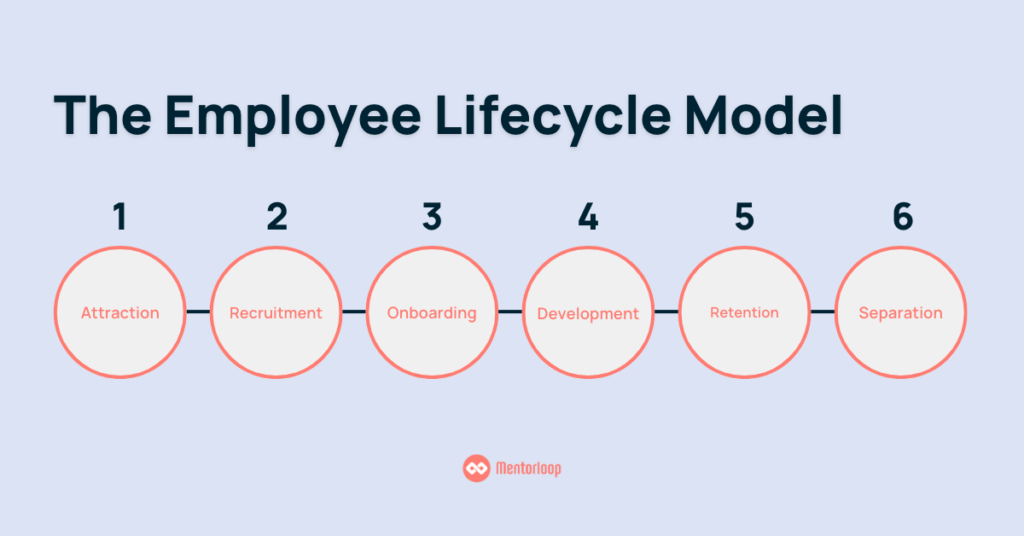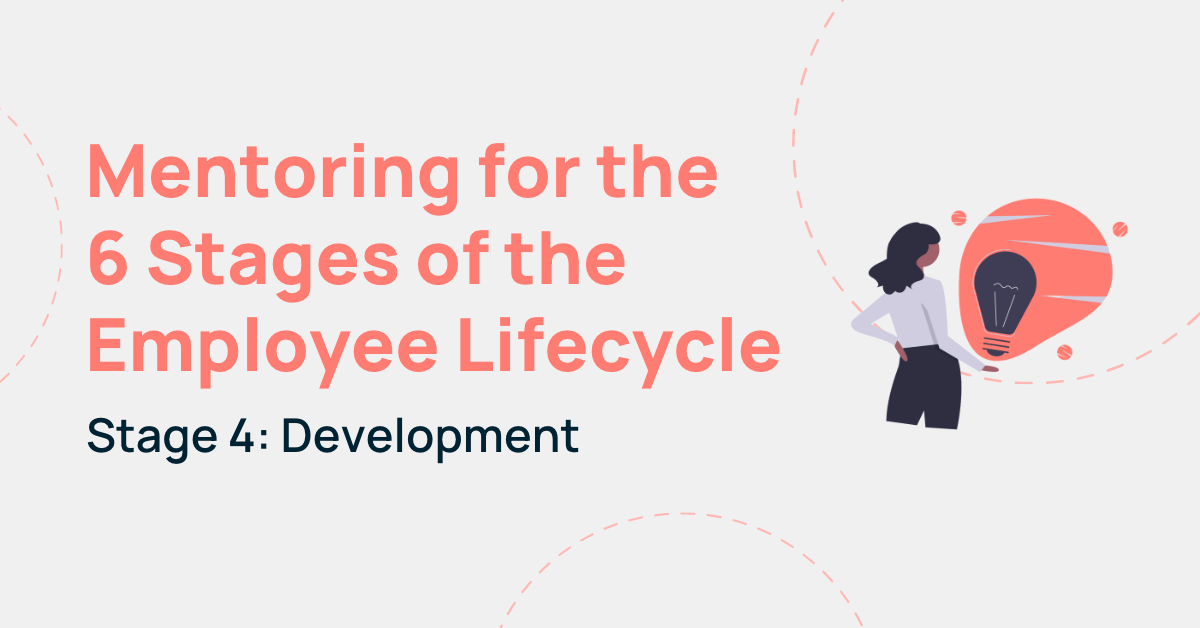In our “Mentoring for the 6 Stages of the Employee Lifecycle” series, we discuss how mentoring fits into every stage of an employee’s journey with an organisation. Why? Because we believe that mentoring should be a part of every employee’s experience – from first touch to exit.
The employee lifecycle model is useful because all employees will pass through similar phases with your organisation. By dividing the employee journey into six stages, it’s easier to identify areas where your company can improve its practices and policies.

Thankfully, mentoring can be a useful tool throughout the employee lifecycle. And with mentoring software like Mentorloop, incorporating it into your existing strategies is easy.
The Series Thus Far
So, what have we covered in our series thus far? Let’s do a quick refresher:
- Stage 1 – Attraction: Make sure to include your mentoring program in all of the content you use to promote your company so it’s a part of your organisation’s first touch with potential employees.
- Stage 2 – Recruitment: A mentoring program can not only help you differentiate your company and recruit desirable employees, it can also foster relationship cultivation and help with brand building.
- Stage 3 – Onboarding: A cohesive, strategic onboarding strategy can improve new hire retention by 82% and productivity by over 70%—and this is where a mentoring program can help; employ it to quickly integrate new hires into their roles as well as the company culture, people, and programs.
Next up in our series? Development.
Employee Development in Today’s Workplaces
Employees leaving their employers due to a lack of career development opportunities has only become a bigger issue over time. In fact, back in 2013, Chief Learning Officer (CLO) Media reported 26% of employees left their companies for this reason. Today, however, Guild’s American Worker Survey has found that 41% of those who quit their previous job from April 2021 to April 2022 did so because of a lack of career development and advancement opportunities. Furthermore, about three-quarters of all workers said they would be “very likely” or “somewhat likely” to leave their current employer if they were offered another role with additional education and career opportunities.
So how can you combat this problem and offer your employees opportunities to make progress while in their present roles? Mentoring!
Enhancing Employee Learning and Development Through Mentoring
Using mentoring for your people’s learning and development has become an increasingly popular concept – and for good reason. Mentoring has been proven to create a positive and supportive environment for employees to learn and grow, leading to benefits for both employees and employers. In this article, we’ll explore the many benefits of mentoring for learning and development, how to make it a key part of your organization’s growth strategy, and how to nurture a mentoring culture within your organization.
The Benefits of Mentoring for Employees’ Learning and Development
One of the primary benefits of mentoring for employee development is increased employee engagement. Having mentoring relationships within your organization means mentees have someone to turn to for guidance. As experienced employees share their expertise with less experienced employees or even new hires, important organizational knowledge is passed down from one generation to the next. This helps to build a knowledgeable and skilled workforce, which is critical for any company looking to succeed in today’s fast-paced business landscape.
Mentoring also helps to bridge the gap between the current skill level and the desired skill level of an employee. Having a mentoring program means you’re providing employees with opportunities for learning and development that might not be readily available elsewhere. Instead of just relying on training courses and e-learning, you have your people making meaningful human connections too.
As mentors take their mentees through goal-setting activities, sharing resources, and taking action steps towards growth, they can give their mentees valuable feedback on areas for improvement and help steer them into the right training programs to pursue. increasing the effectiveness of existing learning and development initiatives.
All of these can lead to a boost in your employees’ confidence, accelerated career growth, increased job satisfaction, and a sense of fulfilment in the workplace.
Another benefit of mentoring is that it can help employees build their professional network. Mentors can introduce their mentees to other professionals in their field, which can lead to new opportunities and connections.
Mentoring can also help employees develop their leadership skills as they learn how to guide and support others. This can be particularly valuable for employees who aspire to leadership roles in the future.
Together, these components combine to meet an employee’s need for ongoing learning and development much more than any online or in-person course, coaching, or other temporary programs on their own. A good mentor is a lifelong learning tool for every individual.
Making Mentoring a Key Part of Employee Development
Mentoring should be a key part of any organization’s employee development program but for many, it isn’t. And that’s because there are a lot of fears about what happens when a program isn’t run the right way. There are also hesitations about how much work would be involved in running a program. But as we know now, mentoring programs are essential to employee development. So if you’re looking to make mentoring a key part of your employee development program, there are a few things to keep in mind.
First, it’s important to establish clear goals, expectations, and objectives for the mentoring relationships within your organisation from the outset. This can help ensure that mentors and mentees are on the same page and are working towards the same outcomes. This can include doing things like identifying specific learning objectives and setting timelines for achieving those objectives.
Second, it’s important to match mentees with the right mentors. As a general rule, it’s best to match mentees with mentors who have experience in the areas where they want some guidance and development. This just gives them better chances of getting relevant advice. It can also ensure that the mentoring relationship is effective and meaningful for both parties.
It’s also a good idea to provide mentors with resources and give them time to devote to their mentoring relationships. On the other hand, mentees should be given ample time and opportunities to put what they’ve learned into practice. As regular communication and good rapport between the mentor and mentee is critical to mentoring success, the organization, through the mentoring program coordinators should help these relationships along. This can be done by encouraging mentors and mentees to arrange scheduled mentoring sessions, check-ins, and feedback sessions. You can also hold workshops and other learning and development initiatives that allow employees to apply what they have learned.
Lastly, it’s important to regularly evaluate the effectiveness of the mentoring program and make adjustments as needed. Make sure to regularly ask for feedback from your participants and track progress towards established goals. This allows you to make changes to the program structure or mentor-mentee pairings as necessary.
Nurturing Employee Development Through Mentoring
Once you have established mentoring as a key part of your employee development program, nurturing the relationships between mentors and mentees is important. This means that throughout the duration of your mentoring program, regular check-ins and feedback collection should happen. Program coordinators should also offer support throughout.
And more than just running a mentoring program and encouraging people to join it, level up your efforts by creating a culture of mentoring within the organisation. You can do this by making your mentoring program a key part of your organisational strategy. It’s also critical to get high-level support and participation for it from your C-suite and key other leaders, and incentivise participation in mentoring programs.
Another important aspect of nurturing employee development through mentoring is to ensure that the mentoring program is inclusive and accessible to all employees. Mentorship opportunities should be open to employees at all levels of the organization, regardless of their job title or seniority. It’s also important that the diversity and inclusivity of the program is not just limited to the mentees. It’s important to also have mentors that come from a variety of backgrounds and experiences. By doing this, you’re not only making sure all employees have the opportunity to grow and develop. You’re ensuring that all employees can participate in a culture of learning and development that gives them access to differing perspectives, experiences, and backgrounds.
Promoting Growth Through a Mentoring Culture
As mentioned previously, creating a culture of mentoring instead of just running a mentoring program, is key to promoting growth for your people and your organisation.
When mentoring is embedded in company culture, knowledge and skills are constantly being shared and transferred from experienced employees to newer ones. This allows for the development of a strong talent pipeline of employees equipped with, not only the skills they need to succeed in their roles, but also the knowledge and ability to move upwards or fill in gaps where needed, better decision-making, and the ability to be more creative with problem-solving. It also helps build stronger relationships between employees, leading to increased collaboration and teamwork, which in turn leads to increased productivity and profitability.
A strong emphasis on learning & development also comes with a good mentoring culture. This encourages employees to take an active role in their own development, therefore also helping to create a culture of continuous improvement and innovation within the organisation. This kind of environment is attractive to employees. It encourages engagement and more participation in your organisation’s L&D programs, creating a positive feedback loop.
An organisation with engaged employees who are committed to learning, development, and innovation also helps ensure that the organization is able to adapt to changing market conditions and stay ahead of the competition. So, by providing opportunities for learning & development and creating a supportive, positive environment for growth, organizations can ultimately improve their bottom line.
—
Using mentoring for employee development and making it a key part of a comprehensive employee development program is a powerful strategy for any organization looking to succeed in today’s fast-paced business world. By establishing clear goals and objectives, selecting the right mentors, nurturing mentoring relationships, and promoting a culture of mentoring, companies can help to foster the growth and development of their employees, while also enjoying the numerous benefits of a knowledgeable and skilled workforce.
Improving your Learning and Development Efforts with Mentoring
A big part of employee development is providing your people with learning opportunities. And this doesn’t have to come in the form of training programs, conferences, or seminars.
Mentoring is one of those great people programs that can be used to combat a number of organisational gaps or deficiencies including learning and development. So how can you maximise mentoring to help improve your L&D efforts?
The first thing to do when pursuing employee learning and development outcomes through mentoring is to assess which (and how many) employees you are looking to engage in your L&D-driven mentoring program.
After that, you have a few choices of what type of program you want to run.
HiPo Mentoring
HiPo mentoring or high-potential mentoring is a selective mentoring strategy. It involves filtering and selecting the employees who management sees as having ‘high potential’, and connecting them with a current leader or manager who can help them develop in ways that set them up for personal and company success.
HiPo mentoring can be extremely effective, given that high performers typically have a higher propensity and motivation for ongoing development. The downside is that this strategy suffers from the universal law of diminishing returns, whereby it’s harder to get more potential and output out of someone who is already getting close to maximising their potential through outlets like mentoring, reading, side hustles, and goal-setting.
It’s also not a strategy we usually suggest as we believe that mentoring should be accessible to everyone. However, this strategy is a good addition to your succession planning toolbox.
ACTION STEP
Find and outline the employees who have been earmarked as being future leaders, and chart their likely company progression. Then, you can match them with mentors who can best speak to what their path to their future leadership roles entail.
Democratised Mentoring
With a more democratic approach to mentoring, all, or at least a large group of your organisation, are informed of the mentoring program. All are informed of the benefits and expectations of the program and then left to declare their interest or register.
Most of your HiPo employees will likely sign up for initiatives like this anyway. But with this strategy, those often left on the sidelines are brought into the fold, offering them a new and potentially previously untapped opportunity for new learning and development.
In our experience, there is often significant latent demand for mentoring alongside other learning and development opportunities amongst all employees. Many of the employees who quietly go about their jobs have a deep latent desire for progress and support. Oftentimes, they are set to gain the most from a mentoring relationship that offers them support, encouragement, and confidence.
ACTION STEP
Ask for expressions of interest among your people to gauge demand for the program. Find a scalable mentoring solution to meet that demand, then market your program and launch!
The next question you must ask when building a learning and development-oriented mentoring program is what type of development are you looking for your employees to engage in?
Tacit and Internal Knowledge Transfer
Tacit knowledge, in contrast to explicit knowledge which can be codified and passed on to new employees (in the form of manuals, documents, content, etc.), is difficult to transfer. This is where mentoring becomes extremely valuable as a development tool. Company practices, internal know-how, or ‘secrets’ that can improve productivity and company performance can be transferred to newer or less experienced employees.
Many traditional and hierarchical business models (sales-skewed organisations are a great example) benefit massively from internal knowledge sharing. Management and senior employees have a treasure trove of nifty tricks and a wealth of job-applicable knowledge to share with more junior employees.
ACTION STEP:
Knowledge sharing is always beneficial for your people. When setting up a mentoring program, choose a tool that helps you provide everyone with guidance and resources that can assist them in facilitating that process.
Personal Development
Alternatively, an internal corporate mentoring program can be self-development-oriented. And while the goal of these types of programs is to facilitate personal development, the results have a very positive impact on the organization too. Individuals who feel that they have ample development opportunities and are able to better themselves in work and in their personal lives perform better in their organizations, are more motivated, and are more confident.
However, in contrast to the goal of a more company-focused development program, this type of program should be based on providing the employee with new and interesting ideas, resources, and extracurricular challenges.
ACTION STEP:
Supplement the mentoring program with a number of personal development tools and resources including suggested podcasts, articles, courses, blogs, and books. These tools, combined with useful goal-setting resources like our goal-setting framework, encourage and inspire mentoring program participants to explore new habits, practices, and opportunities that instil a personal passion for learning and development.
The Easy Path to Integration
Ready to employ a mentoring program to help develop your people? With Mentorloop’s Enterprise solution, you’ll be able to not only achieve mentoring magic with our equitable matching algorithm but continue to maintain it through regular strategic consultations with our team of mentoring experts.
That’s right: a fully customised program design, tailored to your organisation, right at your fingertips.
If you’re ready to find out how mentoring can benefit your business, start by checking out Mentorloop Enterprise today.


![[Webinar Kit] Mentoring for the 6 Stages of the Employee Lifecycle Learn how to make mentoring a core part of the employee experience and why it pays off at every stage.](https://no-cache.hubspot.com/cta/default/4058869/interactive-189627182868.png)


